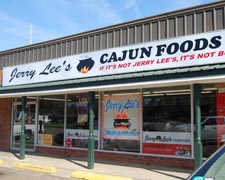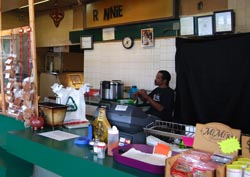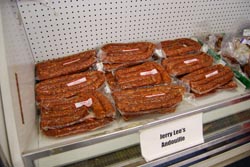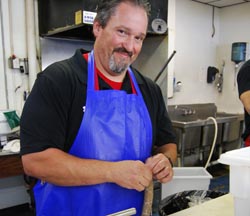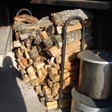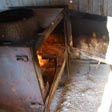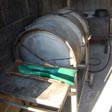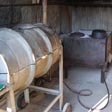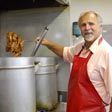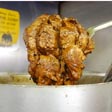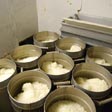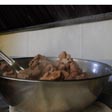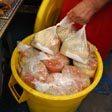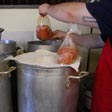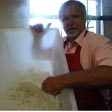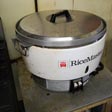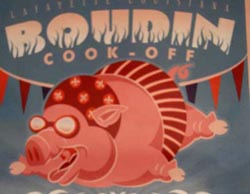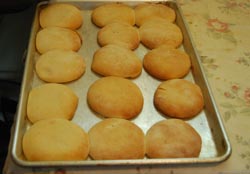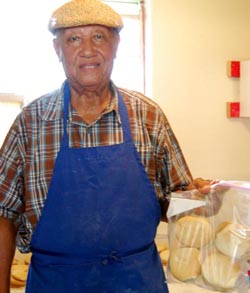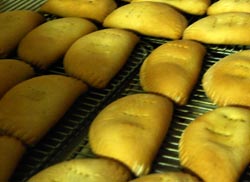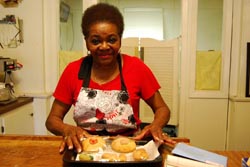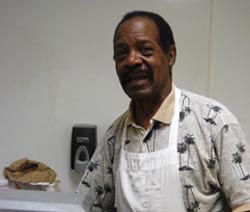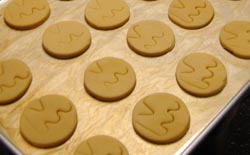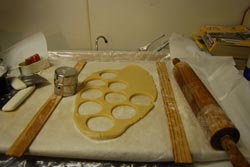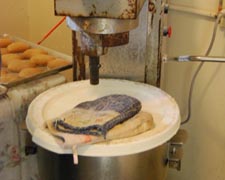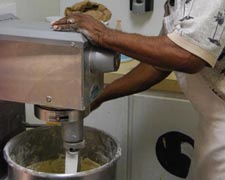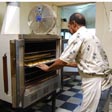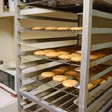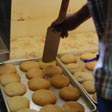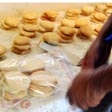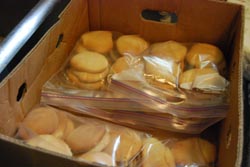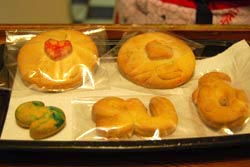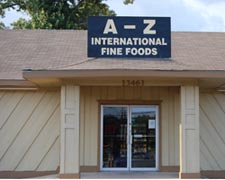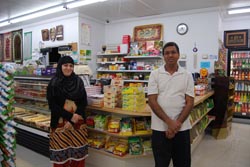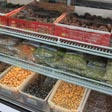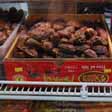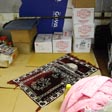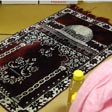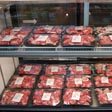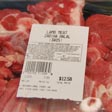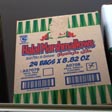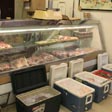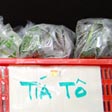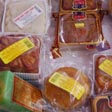Boudin, Teacakes, and Specialty Grocery Stores: Small Food Businesses in Baton Rouge
By Maria Zeringue
Introduction
Baton Rouge is a city of migration and movement, and over the years people from all over the state and the world have come to study, work, and live in the capital city. As Baton Rouge grows, some people move on while others make the city their permanent home. Due to its size and population density, Baton Rouge offers business owners various opportunities to find success. In three parts, this essay explores a diverse group of the city's residents who have opened small businesses. Each section—categorized by boudin makers, teacake makers, and specialty grocery store owners—explores the personal stories behind the process of starting a business in Baton Rouge and the products they make and sell. Of the six people profiled in this essay, three came to the city from different areas of the state like boudin makers Brad Dupont and Jerry Lee Duplantis and teacake maker Junius Dillard. Specialty grocery store owners Michael Thai and Ahmed Badat moved to Louisiana's capital from Vietnam and Pakistan respectively, while Baton Rouge native Emma Royal found a successful business making teacakes by looking for a hobby. Although from different backgrounds, the participants of this project have all incorporated aspects of their own culture into their businesses. Together their stories and the traditions they document offer insight into the diversity of the city and the people who live and work there.
Boudin in Baton Rouge
When boudin maker Jerry Lee Duplantis was a young boy he remembers watching his family make boudin in St. Martinville, Louisiana. He recalls that nothing of the pig was wasted and that the special occasion of making boudin and hogshead cheese was usually a family affair:
In the olden days when I grew up, you'd slaughter a pig, and you know, you'd have your good cuts like the pork chops . . . and what they'd do is take the trimmings, and that's what they'd use to make the hogshead [cheese] and boudin. They used the pork liver as a filling, you know because back then in the old days they had to use every part of the pig. (Duplantis 2014)
Many people in Louisiana enjoy boudin regularly. Instead of slaughtering a pig themselves, they usually rely on grocery stores, gas stations, and meat shops to satisfy their cravings of this specialty sausage. Boudin maker Brad Dupont defines boudin as: "basically a rice and meat sausage. It consists of pork, rice, onions, bell peppers, different seasonings—some people use liver, some people don't—it really just depends on what your preference is and your recipe." Boudin can be found all over southern Louisiana, and it is especially common in the southwestern area of the state in places such as Lafayette, Jennings, and Scott. The latter of which, according to Brad, is unofficially dubbed the "Boudin capital of the world." In 1979 when Jerry Lee started preparing and selling boudin in Baton Rouge, he was one of a handful of people who were making boudin on the eastside of the city.
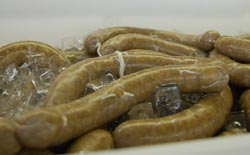
In 2014, there are about 10 to 20 boudin makers in Baton Rouge offering this famous Louisiana sausage to residents of the capital. Two of these boudin makers spotlighted here are Brad Dupont of Ronnie's Boudin and Cracklin House and Jerry Lee Duplantis of Jerry Lee's Cajun Foods. They both have roots in the southwestern area of the state known as Acadiana, where the locals have cultivated a strong and celebrated culinary tradition of boudin making. Jerry Lee and Brad both demonstrate how so many transplants from outside of the city come to Baton Rouge to create their own niche by integrating their cultural and culinary traditions with that of their adopted city.
Ronnie's Boudin and Cracklin House: Brad's Story
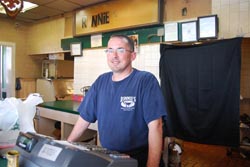
Brad Dupont, owner of Ronnie's Boudin and Cracklin House on Florida Boulevard, was raised eating boudin and says of this famous Louisiana sausage: "it's been a part of my family's culture since well before my parents were born." Brad grew up in Saint Amant, Louisiana, and after he married his wife, Julia Dupont, he moved to Baton Rouge. The couple picked the city because it was the center point between Brad's family in Saint Amant, and Julia's family in White Castle. While in Baton Rouge, Brad started a career in the refinery business, but eventually he was pulled into a lifelong passion of his: cooking. He explains: "I've been into cooking my whole life. I've cooked family meals since I was fourteen years old. It's something I've always done." Brad adds that preparing food was always important to his family especially on his father's side:
My dad's mom is a Cajun cook. . . . My grandmother and my grandfather, they made their own boudin, cracklin, hogshead cheese. I mean they've done that all since they were kids. I mean, growing up in rice farms and on farms over in the Rayne and Church Point area, which they called the 'old country.' (Dupont 2014)
Brad's love of food also comes from his mother. While Brad was working in the refining industry, he made beef jerky from his mother's recipe that she created over 20 years ago, which he calls "Mom's cowboy jerky." Eventually, Brad wanted a platform to sell his beef jerky, which led him to the specialty meat business. Brad's current store originally belonged to Calvin and Henrietta Bellard. The Bellard family started their boudin and cracklin business in Opelousas before opening a second location in Baton Rouge fourteen years ago. In 2011, Brad bought the business from Calvin and Henrietta's daughter, Ginger, and over the last four years, he has worked to transform the boudin and cracklin shop to suit his own tastes and culinary interests. He created a boudin recipe using Calvin and Henrietta's family formula as a starting point. During his first month making boudin at Ronnie's, he altered the Bellard's recipe to his own liking by developing his own seasoning mix, which he says is the secret to his boudin. The Florida Boulevard location is now the flagship store for Brad's business, which he recently expanded to add a second location in nearby Hammond last year.
He describes his Baton Rouge store as "a Cajun specialty meat shop that specializes in boudin, cracklin1, [and] stuffed deboned meat." The store has gained a loyal following in the area, and Brad says the store remains busy most days especially during the end of the week from Thursday through Saturday. He offers daily plate lunches, his cowboy beef jerky, and a variety of sausages and meat products. One of his sausages, the brown sugar sausage, was created at the request of a customer. Brad and one of his employees developed the recipe after one of his customers came into the store looking for a sweet sausage. The customer liked what Brad had made, so he decided to put it on the menu. The brown sugar sausage has now become one of his most popular items. Brad also sells smoked sausage that he makes in-house using the store's smoker powered by pecan wood. The smoked sausage and boudin are favorably sought-after by his customers; therefore Brad and his staff smoke meat products all day starting early in the morning until about 5:00 pm to keep up the demand. In addition to sausages, Brad also makes boudin balls, which follow the same recipe as the boudin links, except he uses less broth so that the boudin mixture can be rolled into balls for frying. Of all the items that he offers on his menu, Brad says that the most popular sellers in the shop are steamed and smoked boudin, his homemade sausages, and cracklins.
Jerry Lee's Cajun Foods: Jerry Lee's Story
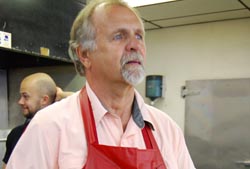
The son of a sugarcane farmer, Gerard "Jerry" Lee Duplantis was born and raised with his siblings in St. Martinville, Louisiana. His work eventually brought him to Baton Rouge where he accepted a job for the Soil Conservation Services. Three years later in 1977, he decided to open up a convenience store with his father-in-law on Greenwell Springs Road, which was initially called Jerry Lee's Kwik Stop. He began by selling the typical fare of gas and groceries, but after a couple of years he wanted to set himself apart from other convenience stores in the area with a specialty item. Jerry Lee wanted to cater to Cajuns in Baton Rouge and attract more customers to his business, so he decided to start making and selling boudin. He explains: "I grew up in Cajun Country. And I knew everybody ate boudin in Cajun Country, so I said, 'they've got to have taste buds in Baton Rouge.' So that's the reason I started making it."
Before Jerry Lee began the process of crafting a recipe for boudin, he sought the help of a boudin maker in his hometown of St. Martinville named J.C. Huval. Mr. Huval gave him a general idea of how to make boudin, and with that knowledge, Jerry Lee went back to Baton Rouge to create his own recipe. It took him about a year to produce boudin that he was truly satisfied with. During that year he called upon a group of Cajun expats living in Baton Rouge to help him refine his recipe. In the beginning years of his specialty meat business, he was making 40 pounds of boudin a week, and he made hogshead cheese in addition to boudin.
Jerry Lee's business was also small enough in the early days to be able use the green onion tops from his home garden that he would peel himself before cooking with them. He started out with just four people working for him, and among those four first employees, Terry Eldridge and Stephen Cangelosi began working for Jerry Lee while they were in high school. After 37 years in business, he has grown from offering two specialty meat items to selling about 14 different products including various types of sausages, pork skins, barbequed beef, and poboys. In 2014, Jerry Lee's Cajun Foods currently makes 1000 pounds of boudin a day, and he is also extremely proud to have a loyal staff of 14 employees including Terry Eldridge and Stephen Cangelosi who are still working alongside Jerry Lee for over 30 years.
Like Brad Dupont, Jerry Lee also makes beef jerky and cracklins, and he smokes his homemade sausages in-house. In lieu of using an electric smoker, he adheres to the traditional method of smoking sausage and beef jerky by using a smoke house that is attached to his shop's kitchen. He burns hickory and pecan wood in his smoker, which gives the meat a naturally smoked taste. According to Jerry Lee, his father and grandfather also smoked meat this way. Another popular item in his store is the hogshead cheese, which is he says is "kind of like a pork paté instead of hogshead like the old days." In the times of his father and grandfather, hogshead cheese was jelled with the head, the feet, and the ears of the pig, but today he cooks the hogshead cheese in "the modern way" because it is easier to prepare by using other ingredients such as Boston butt roast and lean ham hocks (Duplantis 2014). When speaking of the food products at his store such as boudin, hogshead, and beef jerky, Jerry Lee notes that they all come from the Cajun cuisine that he grew up eating with his family, and he is appreciative of the fact that he can a make a living selling the food he enjoys to cook.
Making Boudin
When it comes to making boudin both Jerry Lee and Brad start early in the morning. The staff at Ronnie's starts at 6:00 am every morning and makes about 600 pounds of boudin per day, which includes steamed pork boudin and smoked pork boudin. They also offer steamed or smoked crawfish and deer boudin sausages. Jerry Lee and his employees start at 5:30 am making and stuffing a variety of boudin and other specialty meat items. What follows documents Jerry Lee's approach to boudin making:
It's made different ways, but starting out I get fresh Boston butt pork roast, and I trim them up. I'm using straight butts. A lot of people use the trimmings and cheaper cuts of meat, but I keep it at a high-grade product. And once my meat is processed, I get my vegetables like onions, celery, bell pepper. They call it the Trinity. So I take that and my meat is boiled. And after I boil it an hour or so, I add my seasonings where it don't sink to the bottom too quick. And once it is fully cooked—which takes about two and half hours—I'll take it out of the gravy and grind the meat and strain the vegetables. And grind the vegetables up and, you know, put it back in the gravy. (Duplantis 2014)
After his ingredients are fully cooked, Jerry Lee adds the pork, vegetables, and gravy with the rice, which he cooks separately in two industrial-sized rice cookers. Once his boudin mixture is complete, he stuffs the boudin into casings made from hog intestines. During his first 10 years in business, Jerry Lee used a hand crank machine for stuffing boudin, but then he switched to an automatic boudin stuffer that is powered by water pressure. This machine allows him to stuff 1000 pounds of boudin in about two hours.
Brad has a similar approach to making the traditional steamed pork boudin. He briefly explains his steps to making boudin sausage:
You start by boiling your meat with your seasonings; making the rice; combining everything together with the right amount of broth and seasoning to get your stuffing mixture. Put it in a large stuffing machine, and we personally hand crank ours. We don't have an automated or hydraulic or water stuffing machine. We actually hand stuff ours. We hand stuff it using natural casings—kind of the old way of doing it, nothing synthetic. (Dupont 2014)
The natural casings that Brad uses are medium-grade linings of pig intestines. Brad gets the casings from two meat suppliers in Carencro and Hammond. Brad uses a hand crank machine to stuff the boudin mixture into the casings because it is more cost-effective for his business. To make boudin links using the hand crank, Brad first puts the meat and rice mixture into the stuffer; and then he puts the casing over the nozzle of the machine. During this step, it is important to put a little pressure on the casing so that the stuffing will catch hold of the casing as it comes out of the machine. By turning the crank, the stuffing is fed through the casing, and the boudin mixture becomes a boudin link.
Once Brad stuffs the boudin to the desired length of a link, he starts the process of rolling the boudin, which is defined as spinning or twisting the casing at the end of each link. This step keeps the boudin mixture in the casing and allows him to start stuffing a new link without cutting or separating the sausage links. Brad describes rolling as a delicate process that requires patience and practice because it takes time to perfect the rhythm motion required to spin the casing. Each link is filled with about half of a pound of the rice and meat mix, which measures out to roughly eight to ten inches. Brad interlocks the links by alternating the direction of the spins after making each link. He says that this step is key to keeping all of the mixture into the casing, especially when cutting the links. However, he says that busting links happens occasionally from rolling them too tight or having holes in the casing, so it is important to be patient when stuffing them. He also adds that in the beginning, rolling boudin was hard on his hands: "When you actually make the links, I mean it can wear your hands down. If you're not used to it, it'll tear your hands up a little bit because your hands stay moist. You're constantly rolling this piece of tissue back and forth. It can wear your skin thin." Like Brad Dupont, Jerry Lee and his employees also roll boudin links to about half of a pound each. Jerry Lee and Terry Eldridge have been stuffing for so long that they can just about eye the boudin links to be almost exactly the same in weight. He says, "After you do it for so long—like I have been stuffing boudin for over thirty years—. . . after a while you pretty much have it where each link is about a half a pound." After the links are rolled and stuffed, they are kept on ice and cooled to preserve the freshness of the product before being sold.
What Makes A Good Boudin Link?
In creating a link that they would be proud to offer to their customers, both Brad and Jerry Lee focused their attention on the details of boudin making, such as the importance of the rice to meat ratio, texture, and moistness of this specialty sausage. Boudin is made all over southern Louisiana, and each boudin maker brings his or her own perspective in making the sausage based on family tradition, personal taste and regional culinary norms. Brad and Jerry Lee come from different backgrounds and areas of the state, and their backgrounds influence the boudin and products that they make in Baton Rouge. As demonstrated by Brad and Jerry Lee, the differences that set one boudin maker apart from the next are found in the details, such as the seasoning recipes they have created which they fiercely protect. However, when it comes to the generalities of what makes good boudin, they largely agree. Here are their thoughts on the subject:
Brad: Just good meat portion, not too chunky of meat, not too much of a grind, just a good medium consistency to the meat, tender2, rice grains cooked all the way through but not overly cooked. No crunch to it. Discerning amounts of onions, bell pepper, green onions—you know, you want to be able to see it. You want to be able to see it and not just taste it. And just a good amount of moisture in it to where it's not dry, but not too wet to where it is just kind of messy. You want to be able to eat it through the casing. I don't like to pull mine out of the casing, so I want it to stick. I want it to be a good snap to it. (Dupont 2014)
Jerry Lee: You have to have a happy medium, not over seasoned, not too much meat, and not too much rice. . . . But the main thing is your rice's fully cooked and your vegetables fresh, and you know, a little bit moisture in it and not too, too dry. . . . A good happy medium where everybody can enjoy the flavor. (Duplantis 2014)
The Future of Ronnie's and Jerry Lee's
Brad and Jerry Lee are great examples of people who come from other areas of the state to take advantage of the business opportunities available in a larger city like Baton Rouge. Both Brad and Jerry Lee have found success by sharing their culinary traditions from outside of the city so that local customers can enjoy them. Jerry Lee has also noticed that his import of boudin from St. Martinville has come full circle. He proudly declares that some of his customers in Baton Rouge bring his boudin to family and friends in rural areas nearby. "It's [boudin] from the Cajun family background. I grew up with that and brought it to the city. And now I got city people that bring it back to the country." Jerry Lee's store on Greenwell Springs Road has become a community staple at events that are central to Baton Rouge culture: from serving refinery workers breakfast on a weekly basis to supplying boudin for tailgating parties during Louisiana State University (LSU) football season. Above all, Jerry Lee is most proud of being able to work in Baton Rouge with his family. He says, "It is with great gratitude that I do have a son and a daughter with me that can carry on the tradition of Cajun food." On the future of his business, Jerry Lee is confident that his family and longtime employees will continue his boudin legacy for another generation to come. He states, "I'm 66 years old. I started when I was 28. I've trained up my son, daughter, and employees, and they know exactly what I want in a business, and I think they'll keep that tradition going."
As relatively young business owners, Brad Dupont and his wife Julia are already making a name for themselves in Baton Rouge. They are well-known in the area for their cracklin and smoked boudin, and with the latter, they won first place at the 2013 Boudin Cook-Off in Lafayette, Louisiana for the specialty boudin category. Brad views his accomplishment in the boudin contest as a positive sign for the future of his business, and the fact that he won in the Lafayette area holds a special significance for him. He states: "Anytime you can go into the area where it's known for and win. . . . To win it was really good." As for the future prospects of his store, Brad hopes that he can one day expand and grow his business while staying in the Florida Boulevard area of East Baton Rouge. Despite the economic woes felt all over the country in recent years, Brad believes that making boudin will continue to be profitable in Baton Rouge because the sausage holds a place of importance in Louisiana culture. He says, "People grew up on this stuff. Their kids like it. Their grandkids like it, so they're going to continue to come and buy it."
Teacakes in Baton Rouge
A teacake is a round, soft cookie made with eggs, butter, sugar, flour, vanilla, and nutmeg. Every recipe differs depending on personal tastes. For example, some teacake recipes may call for additional ingredients such as lemon zest; or, teacakes from different regions may be crispier or softer than others (Royal 2014, Dillard 2014). According to The Teacake Project—a website that collects oral histories about teacakes throughout the South—this cookie gained popularity in African American communities during the mid-20th century when families enjoyed them at social gatherings and on Sundays after church (Mackey 2011). Similar to what Brad Dupont says of boudin being "intertwined in the culture here;" teacake makers Junius Dillard and Emma Mensia Royal would agree that their success in Baton Rouge is based in part on the cultural importance of teacakes in Louisiana as the state also belongs to a larger Southern culture. Both Junius Dillard and Emma Royal have been making teacakes in the city for many years. When asked about their popularity, Emma suggests that simplicity is another reason why so many people love teacakes. She says, 'It's just a plain and simple cookie, but it's flavorful. Flavors make the difference."
Dillard's Teacakes: Junius Dillard's Story
Junius Dillard was first introduced to teacakes from his wife who grew up making teacakes with her family. His wife's older sister, nicknamed Nanny, gave her the family recipe that came from their grandmother. Junius says that his sister-in-law first learned how to bake by watching their grandmother, which he describes here:
This is a grandmomma's recipe here. This is not a momma's. There's a difference between momma and grandmomma. . . . A grandmomma when she bakes, she puts in a dab of this and a dab of that. A momma has to have a recipe. Her grandmother, they didn't use measurements. Think about it. They put a dab of this and a dab of that and you've just got to catch it. (Dillard 2014)
Junius adds that his wife learned how to bake in the same way by watching her sister Nanny make the cookies. She first started making teacakes for the family in Houma, which eventually blossomed into a business they called Nanny's Cookies. Junius' wife also made sweet potato pies from a family recipe that used the same teacake batter for the crust of the pies. The transition from a family hobby to a business began when Junius, who served as a minister of a church in Houma, wanted to help his church financially by organizing a fundraising event where he sold his wife's teacakes and pies. The baked sweets were a great success, and they were able to assist in building a church in Houma.
After a few years, his work in the ministry brought Junius and his family to Baton Rouge in 1977. He explains, "When we moved here it was to build a church in Baton Rouge, and the teacakes and pies followed us." In their new city, the Dillard's continued to fundraise by selling teacakes and sweet potato pies. They were so popular; they were able to help build five churches with the money they earned from their baked goods. After the five churches were built, Junius and his wife focused on making teacakes and sweet potato pies fulltime with his wife doing the preparations and baking while he was in charge of selling them. He explains, "She did the baking, the putting together. I did the selling. That's the way it started. I built a business here in Baton Rouge because of going out to the various business places, and it just grew from one business place to the next."
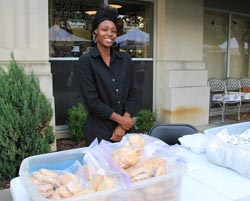
When his wife passed away seven years ago, Junius continued the business with the help of his children and his granddaughter, Adrian Dillard, who is now in charge of selling teacakes on Thursdays and Saturdays at the Red Stick Farmer's Market. On Saturdays Junius' granddaughter sells about 40 to 60 dozen teacakes and 50 pies at the market located in downtown Baton Rouge. On Thursdays, she averages a little less than Saturday's sales because the farmer's market in the Pennington Biomedical Research Center parking lot is much smaller. On Wednesdays and Fridays, Junius brings his teacakes all over the city selling them by the dozen to people at stops along his route, which changes periodically.
Gourmet Goodies by Mensia: Emma Mensia Royal's Story
"I'm homegrown. . . . I've been here all my life," says Emma Royal, the founder and co-owner of Gourmet Goodies by Mensia. Emma, like her parents, was born and raised in Baton Rouge. After her retirement from teaching, Emma wanted to find a hobby that would keep her busy during the next phase in her life. She elaborates, "I decided that I was not ready for the rocking chair so I said, 'Well what else can I do to stay active and to vent my creativity?'" Her answer to that question was baking. She already knew how to make chocolate sculptures, pecan pralines, and pound cakes; so she started baking and selling these items out of her kitchen. In 1991, she and her first husband bought and refurbished the shop she currently operates out of located on Scenic Highway in Scotlandville near Southern University.
When she started the Gourmet Goodies business, she had no idea what a teacake was, but that all changed one night when she was invited to a tailgating party. Emma tells the story of her first introduction to teacakes:
We went to a football game one time, and everybody got so excited when they said that the lady had some teacakes. "Somebody brought teacakes." I didn't know what teacakes were and this was in the 1990s when I went to a tailgate party. I said, 'Well, what are teacakes?' And my husband explained to me what they were. (Royal 2014)
She tasted a teacake for the first time at that party, and the cookie did not initially impress her. However, she was taken aback by their popularity with all of the guests there, so she decided to try and include them on her menu. After trying several recipes, she still was not satisfied with the final product, so she decided to improvise and add her own ingredients that she thought would enhance the mix of recipes she found in books. When she settled on the right teacake recipe for her business, she took a batch of cookies with her to a nursing home to market test her product. She explains, "I said, 'Well these people are supposed to know what a teacake tastes like'; so after I got their okay, we got started with the teacakes."
Her teacakes soon became an extremely popular item on her menu that included a variety of baked goods such as three kinds of homemade pies, six different types of pralines, gift trays, gift baskets, prize-winning chocolate and pecan cookies, wedding cakes, and birthday cakes. However, after ten years of baking as a hobby, she was happy but became overwhelmed with her shop because she was doing all of the work by herself. She explains, "It was a hobby at first and then it just blossomed beyond my expectations." She decided to close the shop in 2001 after her husband passed away, but eight years later she reopened Gourmet Goodies in 2009 when her second husband, Harold Royal, elected to take on the daily operations of the business. In 2014, Gourmet Goodies has returned to being a fun hobby for Emma because she does not have all of the stress of running a business by herself. In addition, they have downsized the menu to three items: teacakes, pecan pralines, and pecan cookies that she calls "crispies".
Making Teacakes
Making teacakes is similar to making other types of cookies or baked goods in that the measurements required of the recipe must be precise in order to yield a consistent product, especially for bakers like Junius and Emma who bake on a large scale. The measurements and even some of the ingredients used in their teacakes are guarded with much secrecy to protect their business. For example, only the members of Junius' family know the exact ingredients of his teacake recipe. He explains, "As far as putting the items together, no one knows that. It's in the family." However, for Junius, keeping the recipe in the family is more about creating a family legacy and a continued tradition than about secrecy. He adds, "It's rewarding to me that we could leave something that they [his children] can continue. And they can look back and say, 'Well my dad or my grandfather left this business for me.' And then they'll have a testimony accordingly." Like Junius, Emma also closely holds her recipe, and she even stamps an 'M' for Mensia so that no others can pass their cookies off as hers as once happened in the past.
Understandably so, both Junius and Emma were reluctant to talk much about the ingredients they use and exactly how they make their cookies, but they were generous enough to talk about some of the steps involved in making their popular teacakes. Junius Dillard combines all of his ingredients to make the batter and then he blends it together in a large mixer. Once he has achieved the desired consistency of his dough; he then stores it in large containers. For the most part, Junius completes all of these steps himself, but he does get help from a friend who rolls all of the dough, cuts them into circular shapes, and then places them on a pan. Junius does the majority of the personal deliveries of his teacakes himself, so he can only prepare the cookies a few days during the week.
On these days, when he is not mixing the dough, he bakes the cookies that are already rolled, cut, and placed on trays. Junius is a meticulous worker and over the years, he has perfected his system of baking and bagging the teacakes. His method also allows him to bake what he will need for the next day or couple of days. He explains, "I have it down to an art as to how many I am going to get rid of in the course of a day. . . . When I go out, I get rid of everything." Junius also adds that it took him a few years and some mistakes to get to this point. As of now, he usually bakes about 20 dozen teacakes at a time. He can do this relatively quickly, (just over an hour) due to the Subway oven that he bought years ago. With a bigger oven he can make six trays of 15 teacakes each at one time. Each batch of teacakes takes about 15 minutes to bake.
Once the teacakes are finished baking he wipes any excess flour on the cookies. Next, he separates them while they are still hot in the pan; and then he removes them from the tray to a long table where they cool before bagging the teacakes by the dozen. Emma's process is similar, but because she has a brick and mortar store, she bakes teacakes everyday starting an hour before opening at 9:00 am. She and her husband continue to bake their teacakes throughout the day as needed since she encourages her customers to place an order before picking them up. In addition, Emma's husband Harold sometimes looks at the previous year's sales of a particular day if he needs to gage how many teacakes and pralines to make. On average, Emma says that they bake roughly 800-900 teacakes per day.
Teacakes and the Community
Both Junius and Emma started making teacakes as a hobby that flourished into small businesses, which, in turn, gives them many opportunities to interact with the community. In discussing what motivates them to continue baking and what they enjoy about their work, the theme of community involvement and interaction was the common thread between these two business owners. For Junius, a large part of his job selling his product takes him all over the city on a weekly basis. He starts selling the teacakes along his route at 8:30 am and works until 5:00 pm. In the course of a day, he visits many of the city's neighborhoods in north Baton Rouge, south Baton Rouge, and downtown. In addition, he also stops by various state and city buildings, office buildings, car dealerships, barbershops, and beauty salons. By going out into the community, he has gotten to know Baton Rouge very well through talking to the people who buy his teacakes. His ability and passion for conversation has given him many loyal customers and has led to his success:
I enjoy communicating with people, you know. There are times when going out selling teacakes, just talking generally about world affairs, state affairs, local affairs, you know, you get conversation going. And at times they would not be interested in purchasing my goods, but by the time I am finished: "Gimme a dozen. Gimme a couple of those pies." (Dillard 2014)
He also considers selling teacakes as an extension of his ministry work because he gets to connect with his customers on a personal level, and communicating with his teacake buyers has become his most favorite aspect of the business. He adds, "I'm called to deal with people. Period. I'm a people person. That's what makes it even better. I can handle myself with people and I guess it's God-given talents and God-given gifts for me along with ministerial, where I can put all of that together."
Emma Mensia Royal has also become a cornerstone in her community by selling teacakes in her shop, and like Junius she has a loyal following that spans a couple of generations of teacake buyers. She says that some of her younger buyers today were introduced to her teacakes by their parents who were customers when the shop was open from 1991 until 2001. Emma believes that the quality of a small business' reputation is highly important because, she states, "Your best advertisement is from a satisfied customer." In addition to the quality of her reputation in the community, Emma has also kept her customer base over the years by selling a food product that carries great meaning to people.
She explains, "There has to be a need that you satisfy. And I had no idea people loved cookies so much. No idea. But this was something that I could do." As Emma states, when she first put teacakes on the menu, she could not have anticipated their popularity. By listening to customer stories about this special cookie, she realized—like Brad Dupont regarding boudin—that teacakes also have a nostalgia associated with them that makes them, in some ways, quite "magical," as illustrated in her quote below:
The people seem to love them. The teacakes are comfort food. The Baton Rouge Business Report asked were we in a slump because of the economy. So I said, "Well no," I said, "[When] people get through worrying about their other problems, they come by here and get cookies to calm them down to give them comfort." And to so many of them, teacakes bring back wonderful childhood memories of their grandmother or aunt or some other relative making the treat for them. So in a way they are kind of magical. (Royal 2014)
Specialty Grocery Stores in Baton Rouge
Food plays an important role in the cultural identity of a place. This essay has already discussed two fixtures of Cajun cuisine and African American communities in Louisiana, but what about those who are new to Baton Rouge from outside of the United States? Specialty grocery stores (or ethnic grocery stores as they are also known) sell products that are not typically sold in most American food markets. These specialty stores offer residents, who have made Baton Rouge their second home, the ability to continue their culinary traditions outside of their native homelands. People from around the world are moving to the capital city for various reasons. For example, in the aftermath of Hurricane Katrina in 2005, there was a large influx in the Asian and Hispanic populations because many families moved to Baton Rouge after they lost their homes in the New Orleans area (Thai 2014). Immigrant communities in the city continue to grow which has created more business and competition for specialty grocery stores. Two stores, Vinh Phat and A-Z International Fine Foods, have been in business since the 1980s, and over time, their owners Michael Thai and Ahmed Badat respectively, have seen the steady need and growth for these types of markets in the city.
Vinh Phat Oriental Foods and Gifts: Michael Thai's Story
Michael Thai's parents opened Vinh Phat Oriental Foods and Gifts in December of 1984 several years after coming to Louisiana. In Vietnamese, Vinh Phat loosely translates as "forever expanding" (Thai, personal communication 2014). The Thai family, originally from China, immigrated to Vietnam where Michael was born. After settling in Vietnam for a few years, the family moved to the United States due to the outbreak of the Vietnam War. The Thai's decided on Louisiana because they had relatives there who were also refugees from Vietnam. Michael says that in addition to having relatives in the state, his family chose Louisiana because the environment and the landscape were similar to Vietnam. His parents also liked that Baton Rouge was a small town when they arrived over 30 years ago. The city as it had existed back then was different from the Baton Rouge that the Thai's live in today. The city had not yet fully expanded into the eastern part of the parish, and Michael remembers that the Florida Boulevard area where his family started the store was a nearly vacant part of town as illustrated by the story of how Vinh Phat's shopping center got its name: "The owner of the shopping center named this shopping center Far East because it's so far east of everything else. It was pretty much nothing out in this area, but you know, it gradually grew up" (Thai 2014). Furthermore, the Asian community in Baton Rouge 30 years ago was very small, and according to Michael, there was only one Asian mini-mart located on Plank Road. Even though there was not a great need in the area to open an Asian grocery store, Michael's parents decided to take the risk because they were experienced in business and Michael's father wanted to create a better life for his family in his new country. Michael says:
My parents were actually in business in Vietnam, so they were in business their entire life. It was just, you know, common sense that that's what they're going to do. . . . We took a big risk. We did what we knew how to do best, really: running a business. And the risk was pretty much like I said—out here there was nothing. It was either you make it, or you would just go out of business within a few years. (Thai 2014)
After the first few years of struggling financially, the risk paid off, and the Thai family was able to make a living from their grocery store business. As the Asian community grew in Baton Rouge with the influx of Vietnamese families to the area in the 1980s, Vinh Phat became more successful. The grocery store now has grown to accommodate other Asian populations as well as Latino and African customers living in Baton Rouge. To keep up with his growing business, Michael works seven days a week at the store with his parents and two other part-time cashiers. Of working closely with family, he says, "We all have our family problems, but most of the time, it's a very good environment, a happy environment."
A-Z International Fine Foods: Ahmed Badat's Story
Ahmed Badat, owner of A-Z International Fine Foods, came to Baton Rouge from Pakistan in 1985. Like the Thai family, the Badat family chose Baton Rouge because they had relatives living here, and they liked the city's small size. Ahmed followed his father who arrived in Baton Rouge two years earlier to open a grocery store that catered to the Muslim population in the area. At the time of the store's opening, there were many Muslim students from Malaysia studying at LSU, who made up a large portion of the food market's early customer base. Ahmed says that these students were looking for products that adhered to their faith's dietary restrictions, which were not offered by most grocery stores in town. In 2005, Hurricane Katrina damaged their original store that was located on Florida Boulevard; however they were able to move that same year to their current location on Tiger Bend Road. Ahmed says that changing locations has allowed them to expand their customer base to include Indian, Turkish, Bulgarian, Lebanese, Cuban, and Latino customers. The success of Ahmed's business offers and the diversity of his customer base enable him to offer specialty items that are difficult to find elsewhere in the city such as certain spices, teas, and olive oils. Despite his love for small towns, Ahmed views Baton Rouge's growth as positive for his business because it continues to grow with the city.
Providing Cultural Commodities From Home
Vinh Phat and A-Z International Foods carry many items that other grocery stores do not stock because, as specialty grocery stores, they cater to an array of Baton Rouge's diverse communities. These stores allow people from various backgrounds to find foodstuffs and products from their native countries or from places they have visited. The items offered by Vinh Phat and A-Z Foods vary from imported dates for Ramadan3 to Turkish mineral water.
At A-Z International Foods, Ahmed Badat even has a prayer room to accommodate his Muslim customers who practice the custom of praying five times a day. The prayer room is a small space in his storage area behind the meat counter that offers some privacy from the rest of the store. Ahmed created this space so that he and his wife could fulfill their duties of prayer while at work. The prayer room is also open to customers who need to pray while shopping or running errands, and a sign hangs near the register to let customers know that they are always welcome to use the space.
In addition to the prayer room, Ahmed Badat at A-Z International Foods sells halal4 meat such as goat, beef, and lamb. For Muslims, halal means that an animal or animal product can be eaten because it is clean and healthy at the time of death and that a ritual prayer is said before the animal is slaughtered. To insure that his meat is halal for his customers, Ahmed slaughters the animals himself at Roucher's Meat Market in the nearby town of Plaquemines. His father taught him how to perform the halal ritual4, which Ahmed says is a brief process. Once every one to two weeks he performs the halal ritual called Zabihah, in which Ahmed holds the animal's head and cuts his throat while reciting the prayer: "Bismillah, Allahu Akbar5" (Badat, personal communication, June 2014). This prayer is repeated until the animal is dead. Ahmed also clarifies that the animal cannot suffer during this rite, so he must use a sharp knife. Not every Zabihah is carried out in exactly the same fashion, but for Ahmed's family, they are accustomed to preparing the animals to be halal in this way. All of the animals slaughtered by Ahmed are butchered by the Roucher's facility, which are then sold by Ahmed in his store.
Vinh Phat, on the other hand, specializes in offering a variety of produce and meat products that are sought-after among the Asian population of Baton Rouge. For example, Michael sells beef shanks, pork hocks, and chicken feet, which are used in many dishes in the Dim Sum6 restaurants in town. Another item that shoppers will rarely find in most Western chain grocery stores is pork blood. Michael says that his Vietnamese customers like to buy this for making a type of hot soup that is common in the cuisine of Vietnam. The staff also sells cuts of meat that cater to Asian cuisine such as pork feet. Most of the items come precut and prepackaged from their suppliers, but for some items like pork feet, the store will quarter them onsite because customers generally prefer to cook with them in smaller pieces.
Similar to most grocery stores, Michael Thai at Vinh Phat carries seasonal items for holidays like Christmas and New Year's as well as Asian special days such as the Autumn Festival. During the festival—also called the Moon Festival—it is customary for people to eat moon cakes, but Michael is noticing that the current trend of his customers is to buy the cakes for their family and friends.
He explains, "Now a lot of people are watching their health, so the moon cakes are getting less and less popular because of all the sugars and all the unhealthy stuff, but it tastes good and it's traditional so people still buy it." Vinh Phat imports the moon cakes from Hong Kong or Canada, where there is a large Asian population.
There are several types of moon cakes. The simplest one would be a dough that is filled with sweet bean. . . . It's shaped in the round shape like the moon, and on top they will have some kind of impression of either a trans [Chinese] character or some kind of picture on it. So it's about the looks. . . . Kind of like the moon in shape. They get really, really into the moon cake as far as like the fillings and stuff. Some of them will have multiple fillings on the inside, what they call . . . in English we call it mixed fillings, but in Asia, they call it differently. But basically, it has anything . . . from eggs to pecan nuts to cashews to anything to anything mix in there. Usually the more they mix in there, the higher the prices. Cakes can get really expensive. I mean it can get up to about $20, $30 dollars for each cake depending on the company that makes it. A known company that is very good for making moon cakes, it gets really high.
Moon cakes are small, measuring about the size of a hand, but because they are so sweet, Michael states, "You don't want to eat a big moon cake."
Specialty Grocery Stores as Cultural Maps of the City
When Vinh Phat first opened in the 1980s, Michael Thai remembers that the majority of his customers were Vietnamese. During that same period at A-Z Foods, Ahmed Badat recalls that the majority of their customers were Malaysian students studying at LSU. For both of these grocery stores, the variety of shoppers has changed dramatically over the years to include people from different nationalities. In the last five years at Vinh Phat, there has been a steady influx of Latino customers in addition to the Filipino, Chinese, African American, and Vietnamese regulars. At A-Z Foods, Ahmed is witnessing more foreign families shopping at his store as the city gets bigger and more people move here for work. He also sees more people of Indian, Turkish, Bulgarian, African, and Latin American backgrounds shopping at the store than ever before. On the other hand, some of Ahmed's newest customers are locals who have moved back home to Baton Rouge after working in the oil industry in places like Saudi Arabia. These customers are usually looking for items that they miss from their temporary homes abroad. Like Ahmed, Michael Thai notes that he is also seeing more local Louisiana customers than in past years due to the widespread exposure of foreign cultures and cuisine on the Internet. He explains that the openness of his customers to try new food is great for business:
For the most part I think Baton Rouge is a good place for us. We have a lot of interest from the locals here. We have a lot of locals who are coming by . . . and a lot of times they'll come by and they want to try out stuff. People who never know what we sell here, they'll come by and they'll get a few items. They'll go and they'll come back because they like it. People are open-minded and we have a lot of that coming in here now. (Thai 2014)
The ever-changing populations of people who shop at Vinh Phat and A-Z Foods demonstrate the great diversity that exists in Baton Rouge. Both businesses stock products that serve an array of cultures, and as Ahmed says, the changes of the products on their shelves offer a cultural map of the many kinds of residents that have called Baton Rouge home both of the past and present.
Conclusion
Like the specialty grocery stores, the stories behind the boudin and teacake businesses also add the to cultural map of Baton Rouge: a map that has changed and extended it boundaries over the years as more people move in and out of its borders. Behind every business there is a story, and as this essay demonstrates no two stories of occupational folklife are alike. In their similarities, these stories tell how people got their start and the work they had to accomplish in order to continue their businesses. From their differences, the stories shared by Brad, Jerry Lee, Junius, Emma, Michael, and Ahmed help map out the identity of the city and trace some of the character belonging to this metropolitan area. Due to its position in the state as the political capital, the reputation of its universities, its burgeoning industry, and its ever-growing population, Baton Rouge is known all over the state, and these factors also make it a particularly interesting city to study. However, there is more to this city than meets the eye. As it gets bigger, there are more businesses opening, more people moving in, which means there are more stories to discover.
Sources
Badat, Ahmed. 2014. Inteview by author, June 20.
Badat, Ahmed. 2014. Personal Communication, August 8.
Badat, Ahmed and Asma Badat. 2014. Personal Communication, June 20.
Dillard, Junius. 2014. Interview by author, June 26.
Duplantis, Gerald (Jerry) Lee. 2014. Interview by author, June 20.
Dupont, Brad. 2014. Interview by author, June 18.
Mackey, Elbert. 2011. "A Traditional Treat of African-Americans Remembered." "The Teacake Roundup". March 10,
Reed, M.H. 2005. "Dim Sum and Other Cantonese Delights." "The New York Times", January 2,
Royal, Emma Mensia. 2014. Interview by author, July 1.
Shelquist, Wahiduddin Richard. 2008. "Bismillah al rahman al rahim." "Living From the Heart", January 3,
Shelquist, Wahiduddin Richard. 2010. "Devotional Phrases in Arabic." "Living From the Heart", Aug 25,
Thai, Michael. 2014. Interview by author, June 24.
Thai, Michael. 2014. Personal Communication, August 8.
Notes
1. Brad defines cracklin as ". . . basically bacon cut the opposite way and fried versus smoked. Instead of cutting it in long thin layers, you cut it in thicker chunks of meat, and it's fried." Making cracklin is a labor-intensive process because it has to be stirred constantly for about one to two hours so that it does not burn. Brad and his staff cook about 1600 to 2200 pounds of raw meat a week to make their cracklin. However, cracklin renders down significantly when it cooks. For example, when Brad cooks 60 pounds of meat, he is only left with about 18 to 20 pounds of cooked cracklin, which explains why the price of cracklin is relatively high (Dupont 2014).
2. When Brad mentions tender is this instance, he is referring to the texture of the meat. The taste, seasoning and texture of the cooked meat must meet his personal criteria of quality before being added to the boudin mixture. For Brad, the taste of the individual ingredients is just as important as the overall taste of the sausage.
3. Ramadan is a thirty-day period in the Muslim faith where followers of the religion fast from sunrise to sunset. Many Muslims break their fast by eating dates. The exact time period of Ramadan is governed by the lunar calendar of Islam (Ahmed and Asma Badat, personal communication, 2014).
4. In two personal conversations with the author, Ahmed and Asma Badat explained the distinction between halal and Zabihah halal. Halal is a dietary law of the Islam religion, which regulates what types of food that Muslims are allowed to eat. In regards to animals, Muslims are allowed to eat animals that are clean, healthy, and slaughtered humanely in the Islamic way. Ahmed stated that animal meat which is certified halal may also be slaughtered by machine if the prayer ritual is also performed at the time of the killing of the animal. However, he specified that the certification of Zabihah halal indicates the meat was prepared and slaughtered by hand and—according to the religion's laws—did not suffer during the process (Ahmed and Asma Badat, personal communication, June 2014 and Ahmed Badat, personal communication, August 2014).
5. In English, the complete phrase "Bismillah, Allahu Akbar" means "In the name of Allah, Allah is most great." The first part of the prayer, "Bismillah," is translated as "In the name of Allah" (Shelquist 2008). During the Zabihah ritual, Ahmed recites this part when starting the slaughter so that his work will be blessed (Badat, personal communication, August 2014). The second part of the prayer, "Allahu Akbar," means "Allah is most great" (Shelquist 2010). Ahmed recites the second phrase as he is cutting the throat of the animal to be slaughtered (Badat, personal communication, August 2014).
6. Dim Sum is a style of Cantonese cuisine that incorporates a variety of small dishes usually served at lunch and accompanied by tea. In restaurants, Dim Sum is commonly served in round bamboo baskets, and typical dishes include dumplings, spring rolls, and steamed buns (Reed 2005).



